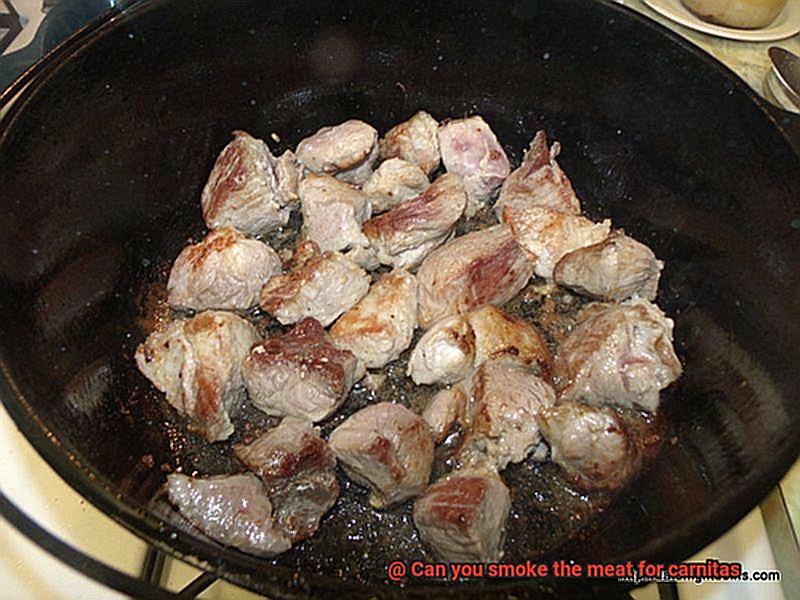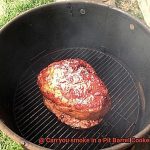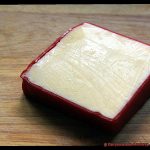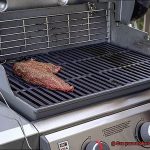Do you find yourself dreaming about the succulent and savory taste of carnitas? This classic Mexican dish has won over the hearts (and stomachs) of countless food enthusiasts worldwide. But some folks may feel unsure about cooking up a batch of homemade carnitas, wondering if they can achieve that same smoky, melt-in-your-mouth flavor found at their favorite restaurants. Well, fret no more. We have the answer to your burning question: Can you smoke the meat for carnitas?
Smoking meat has been a beloved cooking method for centuries, imparting a depth of flavor and aroma that simply can’t be replicated with other techniques. While traditional carnitas are made by simmering pork in lard until tender, then frying it up to get those coveted crispy edges, smoking the meat beforehand can add an extra layer of smokiness and tenderness to your dish.
In this blog post, we’ll explore both the pros and cons of smoking meat for carnitas. We’ll delve into the various smoking methods and techniques that you can use to achieve your desired flavor and texture. Plus, we’ll provide you with a step-by-step guide on how to smoke meat for carnitas like a pro. So if you’re ready to elevate your carnitas game to new heights, read on.
Contents
What Type of Meat is Best for Carnitas?
Carnitas are a beloved Mexican dish that centers around succulent, slow-cooked pork. However, not all cuts of pork are created equal when it comes to achieving that perfect texture and flavor. Here’s what you need to know about selecting the best type of meat for your carnitas.
Traditionally, pork shoulder or “butt” is the cut of choice for making carnitas. This particular cut boasts a high fat content that slowly melts away during cooking, resulting in an incredibly tender and flavorful meat. While other cuts like pork belly or ribs can also be used, they may not have the same level of fat content as pork shoulder. This can result in a drier texture and less flavorful meat.
When choosing your meat, it’s essential to consider the ratio of fat to meat. A 70/30 ratio of meat to fat is generally ideal for making carnitas. This ensures that the meat stays moist during cooking but doesn’t become overly greasy or fatty.
In addition to selecting the right cut of meat, it’s also crucial to choose high-quality pork from a reputable source. Look for pasture-raised and hormone-free pork for the best flavor and texture. Don’t hesitate to ask your butcher for recommendations on which cuts are best for making carnitas.
Once you’ve selected your meat, smoking it is another critical step in achieving that unique and delicious flavor that makes carnitas so special. Hickory, applewood, and mesquite are all popular options for smoking pork, each providing a different flavor profile and intensity. Experiment with different woods to find your preferred taste.
To prepare your smoker for smoking your carnitas meat, it’s important to maintain a low and steady temperature throughout the process. You can use a charcoal or electric smoker depending on your preference and equipment availability.
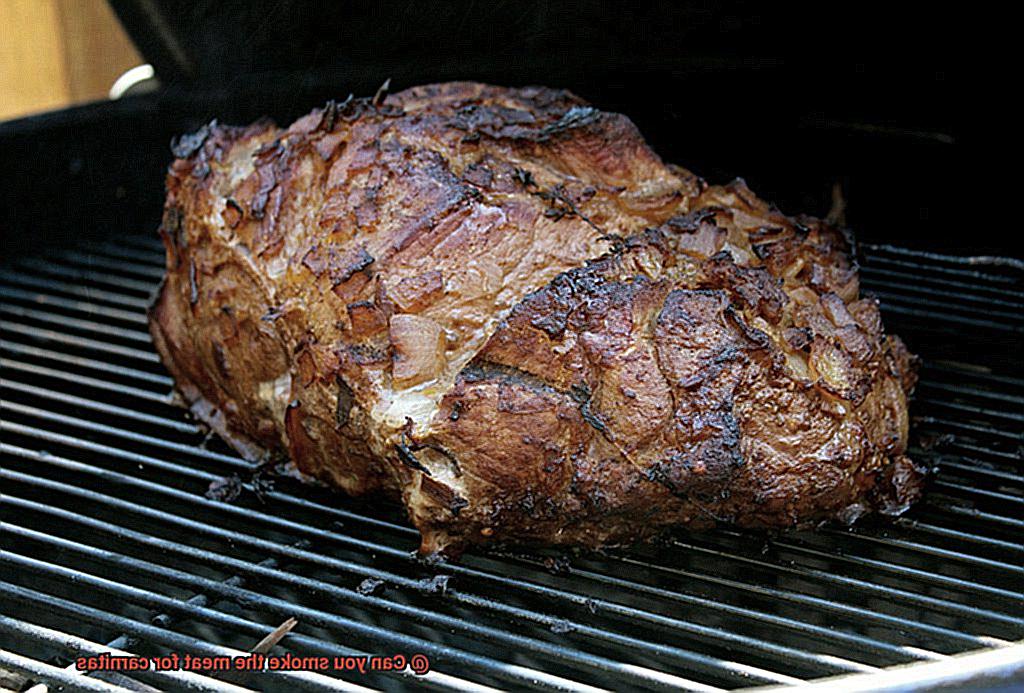
Before placing the meat in the smoker, make sure to season it with a dry rub or marinade to enhance the flavor. After smoking the meat for several hours until it reaches an internal temperature of 195-205°F, let it rest for at least 30 minutes to allow the juices to redistribute throughout the meat.
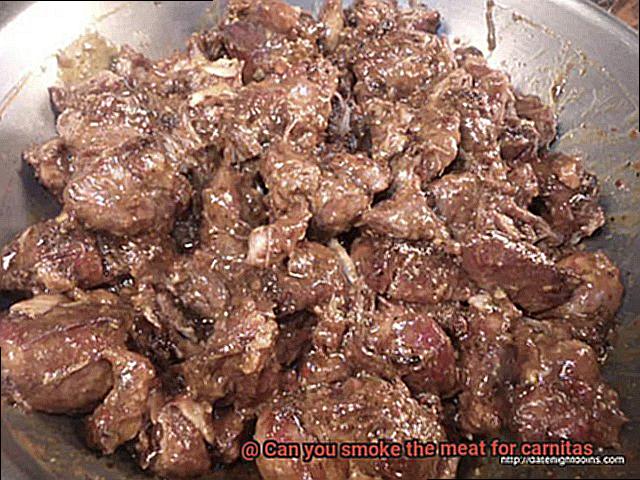
Choosing the Right Wood for Smoking
It’s not just about tossing your pork into the smoker and hoping for the best. Different woods will impart diverse flavors, and you don’t want to overpower or underwhelm your taste buds. Let’s dive into the best woods for smoking carnitas and why they work so well.
Firstly, oak is a classic choice. Known for its mild flavor, it won’t take away from the natural taste of pork. Oak burns slowly and produces a gentle smoky flavor that perfectly complements your meat. If you’re looking for a safe option that won’t disappoint, oak is an excellent choice.
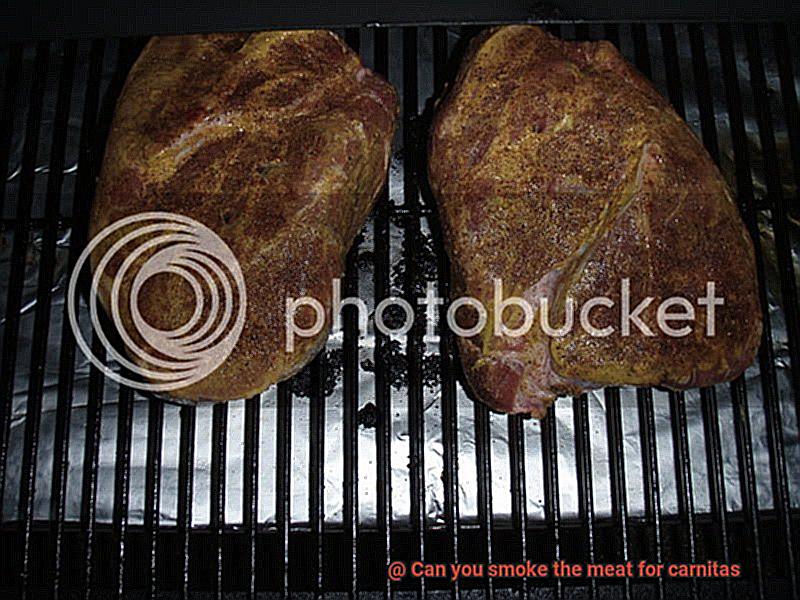
If you’re feeling more adventurous, hickory is another popular option. Its bold and strong flavor can stand up to the robust spices in carnitas. However, be cautious – using too much hickory smoke can make your meat taste bitter. If you want a stronger flavor than oak but don’t want to stray too far out of your comfort zone, hickory may be right up your alley.
For those seeking to add a Southwestern touch to their carnitas, mesquite is a common choice. This wood imparts an earthy flavor that pairs nicely with the spices in carnitas. Remember to use mesquite sparingly though – too much can overpower your meat and leave an unpleasant aftertaste.
Lastly, we have applewood. This fruitwood produces sweet, fruity smoke that complements the natural sweetness of pork. It’s milder than oak or hickory and adds a subtle sweetness to your meat without overwhelming it. For those seeking something different than the traditional woods, applewood is definitely worth trying.
When it comes to smoking carnitas (or any meat), it’s essential to avoid softwoods like pine or cedar. These woods contain high levels of resin that can produce an unpleasant taste and aroma. Stick with hardwoods like oak, hickory, and fruitwoods to get the best results.
Preparing the Smoker
Then, it’s time to get serious about preparing your smoker. As an expert in the art of smoking, I can attest to the importance of properly preparing your smoker before smoking meat for carnitas. With a little extra effort and attention to detail, you’ll achieve a mouth-watering end result that will leave your taste buds dancing.
To start, it’s crucial to ensure that your smoker is clean and free of any leftover ash or debris from previous use. This simple step will help keep unwanted flavors at bay and ensure that your meat cooks evenly.
Next, take stock of your fuel source. Whether you prefer wood chips or charcoal, make sure you have enough on hand to maintain a consistent temperature throughout the smoking process. After all, a fluctuating temperature can throw off the entire cooking process and affect the flavor of your meat.
Speaking of temperature, maintaining consistency is key when smoking meat for carnitas. Aim for a smoker temperature between 225-250 degrees Fahrenheit. To keep an eye on this crucial element, use a thermometer to monitor the temperature inside the smoker.
Ventilation is another critical consideration when preparing your smoker. Proper airflow allows smoke and heat to circulate freely throughout the smoker, resulting in even cooking and flavor distribution. Make sure to open any vents or dampers on the smoker to allow air to flow freely.
Finally, don’t forget about the importance of positioning your meat inside the smoker. For optimal results, avoid having it touch any part of the smoker and instead place it on a rack or hang it from hooks inside the smoker. This ensures proper airflow around the meat and even cooking.
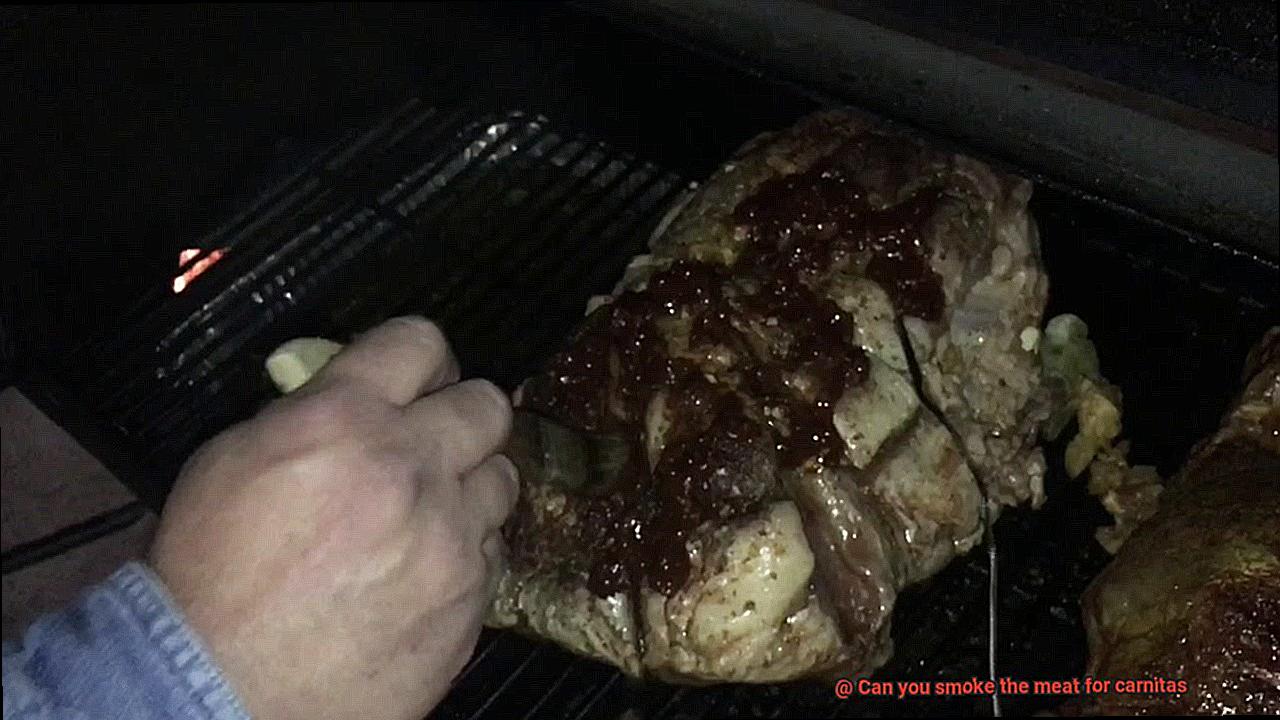
Adding a Dry Rub or Marinade
These techniques can help tenderize the meat and infuse it with mouth-watering flavors that will leave your taste buds craving more.
Let’s start with dry rubs. A dry rub is a combination of spices, herbs, and sometimes sugar that is rubbed onto the surface of the meat before cooking. You can use an array of spices such as cumin, chili powder, paprika, garlic powder, and salt to create a tantalizing rub for your carnitas. To add some complexity to the flavor, try incorporating brown sugar as well. Once you’ve created your perfect dry rub, let it sit on the meat in the fridge for at least 30 minutes before cooking for optimal results.
In addition to dry rubs, marinades are another way to add flavor to your carnitas. Marinades consist of liquid ingredients such as oil, vinegar, citrus juice, and spices that the meat is soaked in before cooking. For your carnitas marinade, you can use orange juice, lime juice, garlic, onion, cumin, oregano, and salt to achieve a tangy and savory flavor profile. To maximize the infusion of flavors into the meat, let it sit in the fridge for at least 2 hours or overnight.
Regardless of whether you choose to use a dry rub or marinade, one crucial step is patting the meat dry before cooking to remove any excess moisture. This helps create a crispy exterior when frying or roasting the meat and ensures that it cooks evenly.
When smoking your carnitas, applying a dry rub or marinade beforehand can further enhance its flavor by allowing smoke to penetrate the meat. Be sure to follow proper smoking techniques and cook until it reaches an internal temperature of 165°F for food safety.
Smoking the Meat for Carnitas
Carnitas are a staple in Mexican cuisine, and smoking the meat before simmering is a game-changer. It’s a simple technique that can add an intense smoky flavor to the dish. Smoking the meat for carnitas involves using a smoker and wood chips to infuse the meat with flavor.
The first step is to choose the wood chips. Hickory, mesquite, and applewood are popular choices, but you can experiment with others to find your favorite. The wood chips should be added to the smoker, which should be preheated to the desired temperature.
Before smoking the meat, it should be seasoned with a dry rub or marinade to enhance its flavor. The smoking process can take anywhere from 2-8 hours depending on the size of the meat and the temperature of the smoker. It’s important to monitor the internal temperature of the meat to ensure it reaches a safe temperature of 165°F.
Once the meat is smoked, it’s time to shred it and simmer it in lard or oil until tender and juicy. A large, heavy pot is recommended for this step to prevent splattering. Experimenting with different types of oil or adding diced onions, garlic, or peppers can add an extra kick of flavor to the dish.
Reaching the Right Internal Temperature
If you’re a fan of carnitas, then you know that the key to a great batch is all in the meat. And to ensure that your meat is safe and delicious, it’s crucial to reach the right internal temperature. So, why is this temperature so important? Let’s dive into this topic and find out.
First and foremost, for pork used in carnitas, the recommended internal temperature is 145°F (63°C). This temperature will kill off any harmful bacteria present in the meat, making it safe to consume. However, it’s important to maintain this temperature for at least three minutes to ensure that all bacteria are eliminated.
So, how do you achieve this temperature when smoking meat? The answer is simple: use a meat thermometer. Make sure to insert the thermometer into the thickest part of the meat and avoid touching any bone or fat as this can give an inaccurate reading. By monitoring the internal temperature regularly, you’ll know exactly when your meat has reached 145°F (63°C) and can be safely consumed.
Keep in mind that smoking meat takes longer than other cooking methods. The low and slow smoking process allows the meat to absorb more flavor and become more tender, but it also means that it may take longer to reach the desired internal temperature. To ensure that your meat is cooked evenly, it’s important to maintain a consistent temperature throughout the smoking process. This can be achieved by using a smoker with a built-in thermometer or by monitoring the temperature regularly with a separate thermometer.
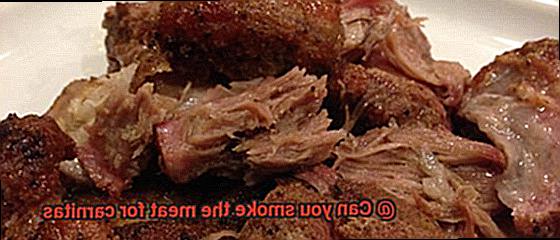
To summarize, reaching the right internal temperature is crucial when smoking meat for carnitas. By using a meat thermometer and monitoring the temperature regularly, you can ensure that your meat is safe to eat and bursting with flavor. Here are some additional tips to keep in mind:
- Always use a meat thermometer to monitor the internal temperature
- Avoid touching bone or fat when taking the temperature
- Maintain a consistent temperature throughout the smoking process
- Be patient, as smoking meat takes longer but is worth it for the delicious flavor and tenderness
Letting the Meat Rest Before Shredding
If you’re a carnitas connoisseur, you know that there’s no room for shortcuts when it comes to achieving that perfect combination of juicy and tender meat. And that’s precisely why letting the meat rest before shredding is a crucial step in the process.
Why is resting the meat so important? When you cook meat, the juices inside move towards the center, away from the surface. By letting the meat rest after cooking, you allow those juices to redistribute throughout the meat, which helps keep it moist and flavorful. This, in turn, will lead to a more satisfying eating experience.
But how long should you let the meat rest? Experts recommend a minimum of 10-15 minutes. During this time, the meat will continue to cook as it settles and cools down slightly. This resting period will also make it easier to shred the meat, as it will be more pliable and less likely to fall apart.
To ensure that your meat stays warm while resting, wrap it in foil or a clean towel. This will help retain heat and keep the meat at a safe temperature until you’re ready to shred it. You can also use this time to prep any toppings or sides you plan on serving with your carnitas.
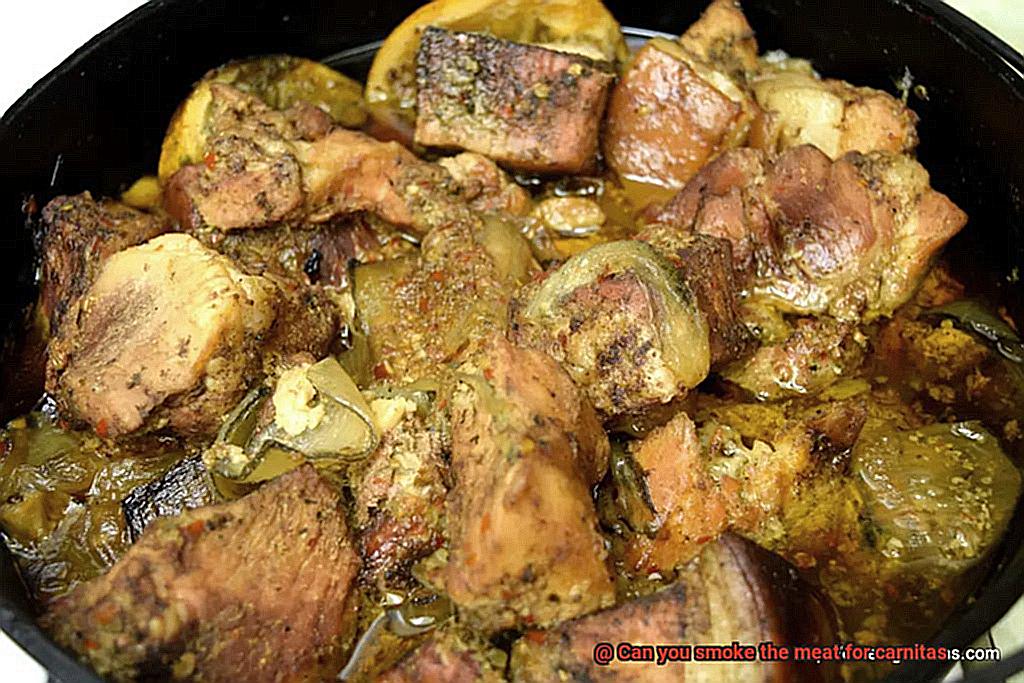
Tips and Tricks for Perfectly Smoked Carnitas
Look no further than smoking your meat for a unique and delicious flavor. But how do you achieve perfectly smoked carnitas every time? Here are five tips and tricks to get you started.
Choose the Right Cut of Meat
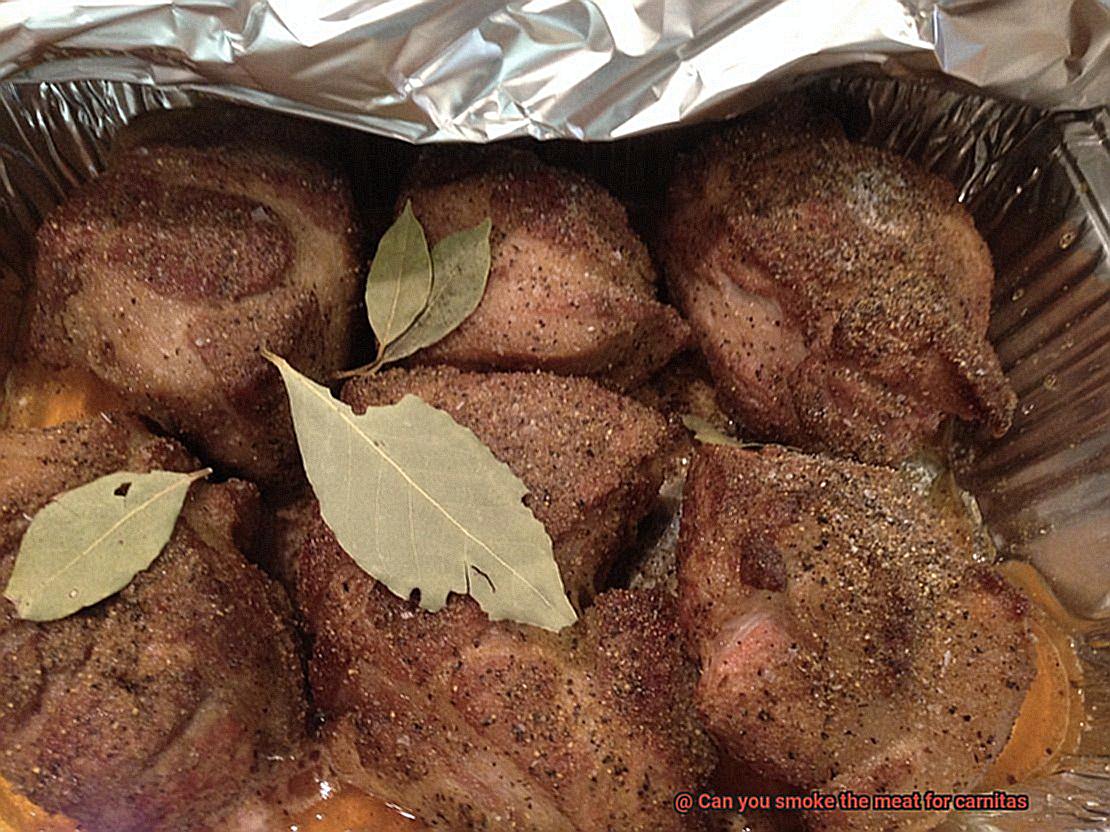
To make juicy and tender carnitas, choose pork shoulder or butt, which have a good amount of fat. Trim off any excess fat or silver skin before seasoning the meat.
Season with a Dry Rub or Marinade
A simple blend of salt, pepper, garlic powder, and cumin can work wonders, but feel free to experiment with other spices and herbs like oregano or chili powder. Let the meat marinate for a few hours to overnight to allow the flavors to penetrate the meat.
Use Wood Chips or Chunks that Complement Your Seasoning
Hickory and mesquite are classic choices for smoking pork, but applewood or cherry wood can add a sweet and fruity flavor that pairs well with carnitas.
Smoke Low and Slow
Maintain a temperature between 225-250 degrees Fahrenheit for several hours to allow the smoke to penetrate the meat and break down the tough connective tissue in the meat for tenderness.
Let it Rest Before Shredding
After smoking, let the meat rest for at least 30 minutes before shredding it with a fork or tongs. This will redistribute the juices throughout the meat for maximum flavor and tenderness.
VHjigBJ_TNg” >
Conclusion
In conclusion, smoking meat for carnitas is a mouthwatering way to take this beloved Mexican dish to the next level. With a few key steps, you can achieve that perfect balance of smokiness and tenderness that will have your taste buds singing.
Firstly, selecting the right cut of meat is crucial. Opt for high-quality pork shoulder or butt to ensure maximum flavor and juiciness. Next, prep your smoker by giving it a thorough cleaning and ensuring proper ventilation. Maintaining a consistent temperature throughout the smoking process is also key.
To amplify the taste even further, experiment with different woods and seasoning techniques. Applying a dry rub or marinade before smoking can help infuse additional flavors into the meat.
Regularly monitoring the internal temperature of the meat using a thermometer is important for achieving optimal tenderness. Once done, let it rest before shredding to allow all those delicious juices to redistribute.
With these tips in mind, you’ll be able to smoke meat for carnitas like a pro.

